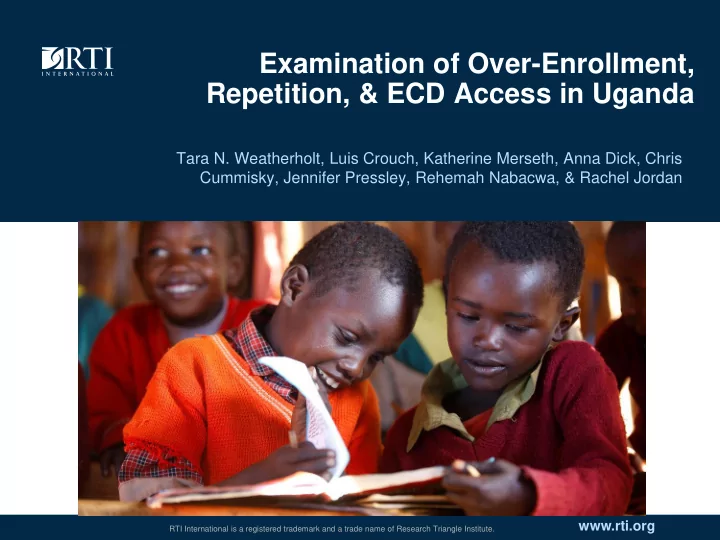

Examination of Over-Enrollment, Repetition, & ECD Access in Uganda Tara N. Weatherholt, Luis Crouch, Katherine Merseth, Anna Dick, Chris Cummisky, Jennifer Pressley, Rehemah Nabacwa, & Rachel Jordan www.rti.org RTI International is a registered trademark and a trade name of Research Triangle Institute.
Descriptive Study Better understand enrollment and repetition in Primary 1 Pre-primary education enrollment 2
Background on Over-Enrollment in Uganda UPE was adopted by the government of Uganda in 1997 – 2.5 million (1996) – 8.2 million (2015) 3
Enrollment with Population Overlay: Uganda Enrollment with Population Overlay P7 P6 P5 P4 P3 P2 P1 0 500,000 1,000,000 1,500,000 2,000,000 Population of Appropriate Age Enrollment Source: Graphed by the authors from enrollment data sourced from the EMIS 2013 (Ministry of Education 2014) and, for population, direct download of World Bank’s EdStats system data (http://datatopics.worldbank.org/education/wDataQuery/QFull.aspx.) 4
UGANDA Context • No government-funded pre- primary • 11% of children attended pre-primary education programs (2013 Gross Enrollment Rate, UIS) • Official age of enrollment for Primary 1 is 6-years-old. • Repetition is discouraged 5
Research Questions: Descriptive Study Methodological - Testing a method of collecting enrollment, repetition, and preprimary data through school record reviews and interviews What are the pupil enrollment numbers and ages in Primary 1 in a sample of schools in two differing districts, as reported by school records? What are the pupil repetition rates in Primary 1 in a sample of schools in two differing districts, as reported by school records? 6
Research Questions: Descriptive Study What are the ages of a sample of pupils in Primary 1 in two differing districts, as reported by parents? What are the repetition rates of a sample of pupils in Primary 1 in two differing districts, as reported by parents and teachers? What are the rates of preprimary enrollment of a sample of pupils in Primary 1 in two differing districts, as reported by parents? 7
Sample & Measures 2 Districts: 40 schools each, 24 pupils per school • KUMI: High reported repetition rates (11.6%, 2014), low performance, low pre-primary access, more rural • MBALE : Low reported repetition rates (1.6%, 2014), high performance, high pre-primary access, less rural Measures Classroom-Level • Head Teacher records (n = 64) • Teacher records (n = 72) • Classroom Headcount (n= 88) Pupil-Level • Parent Interviews (n = 1772) • Teacher Interviews (n = 1909) 8
Classroom Level Data 9
Enrollment: School Records & Head Counts (N=55) Average Enrollment 180 156.5 160 149.7 Average Number of Children 140 120 110.6 97.9 97.4 100 80 70.1 60 40 20 0 Kumi (high-risk) Mbale (low-risk) Headcount Teacher Records Head Teacher Records 10
Age for Grade Mean Percentage Pupils Under-Age and Over-Age for Grade (N=55 records) Kumi (High-Risk) Mbale (Low-Risk) HT Teacher HT Teacher % Under-age .8% .6% 3.2% 1.4% 35.4% 42.3% 32.5% 34.2% At Age 6 % Over-age 58.2% 38.8% 60.6% 51.7% 11
Age for Grade Mean Percentage Pupils Under-Age and Over-Age for Grade (N=55 records) Kumi (High-Risk) Mbale (Low-Risk) HT Teacher HT Teacher .8% .6% 3.2% 1.4% % Under-age At Age 6 - 7 67.3% 72.4% 66.3% 70.6% 31.7% 8.7% 26.8% 15.3% % Over-age 12
Repetition: School Records (N= 55) 2016 Mean Repetition Rates: Classroom Level 30 25.5 25 Percentage of Children 20 Head Teacher 15 Teacher 10.7 10 7.7 5 0.8 0 Kumi (High-Risk) Mbale (Low-Risk) 13
Pupil Level Data 14
Age of Sampled Pupils: Parent Report (N=1772) Kumi (High- Mbale (Low- risk) risk) Child’s Age N % N % 3 or Less 1 0.1% 0 0.0% 4 2 0.1% 7 1.0% 5 48 4.7% 63 7.5% 6 249 25.7% 210 23.1% 7 304 34.7% 299 33.1% 8 181 21.7% 167 18.9% 9 61 7.1% 59 7.0% 10 19 2.6% 30 3.4% 11 or More 5 0.6% 13 1.6% Don't Know/ No 20 2.7% 34 4.4% Response 15
Age for Grade: Parent-Report Percentage of Sampled Pupils Over-Age and Under- Age for Grade 100% 80% Percentage of Children 60% 5 & Below 7 & Above 40% 20% 0% Kumi (High-Risk) Mbale (Low-Risk) 16
Age for Grade: Parent Report Percentage of Sampled Pupils Over- and Under-Age for Grade 100% 80% Percentage of Children 60% 5 & Below 8 & Above 40% 32% 30.90% 20% 8.50% 4.90% 0% Kumi (High-Risk) Mbale (Low-Risk) 17
Repetition of Sampled Pupils Reported Repetition Rate 100% 80% Repetition Rate 60% 48% Parent 39.80% Teacher 38.90% 40% 30.23% 20% 0% Kumi (High-Risk) Mbale (Low-Risk) 18
Repetition: Comparison of Sources Kumi Mbale SOURCE (High-Risk) (Low-Risk) EMIS 2015 P1 Repeater Rate 9.8% 2.2% Head Teacher Records 7.7% .8% (Classroom Level) Teacher Records 25.5% 10.7% (Classroom Level) Teacher Interview 38.9% 30.23% (Pupil Level) Parent Interview 48% 39.8% (Pupil Level) 19
Preprimary Enrollment: Parent Report Pre-primary Enrollment of Sampled Pupils 100% 84.80% 80% Percentage of Pupils 60.20% 60% Pre-primary 39.40% No Pre-primary 40% 20% 15% 0% Kumi (High-Risk) Mbale (Low-Risk) 20
Preprimary & Repetition: Parent Report Pre- Did not Primary Repeated repeat Status No Pre- 374 384 Kumi Primary (High- Risk) Pre-primary 98 33 No Pre- 263 273 Mbale primary (Low- Risk) Pre-Primary 236 97 21
Years of Pre-Primary & Repetition: Parent Report Years of Pre- Repeater Rate primary 1 13.3% 2 1.9% 3 0.9% 22
Summary of Results Majority of children are over- age for grade Parent-report higher repetition rates than reported in EMIS and school records Attending pre-primary lessens chance of repeating Promising methodology for studying enrollment and repetition and for engaging parents – 93% parent participation 23
Resources Crouch, 2016 Graph by the authors from enrollment data sourced from the EMIS 2013 (Ministry of Education 2014) and, for population, direct download of World Bank’s EdStats system data (http://datatopics.worldbank.org/education/wDataQuery/QFull.aspx.) World Bank EdStats download 24
Recommend
More recommend